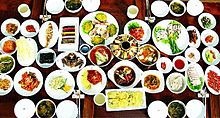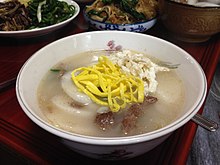
Back مطبخ كوري Arabic Koreya mətbəxi Azerbaijani Корейска кухня Bulgarian Korejská kuchyně Czech Koreanische Küche German Korea kuirarto Esperanto Gastronomía de Corea Spanish آشپزی کرهای Persian Korealainen keittiö Finnish Cuisine coréenne French




 |
| This article is part of a series on |
| Korean cuisine 한국 요리 조선 료리 |
|---|
 |
| Part of a series on the |
| Culture of Korea |
|---|
| Society |
| Arts and literature |
| Other |
| Symbols |
|
Korean cuisine has evolved through centuries of social and political change. Originating from ancient agricultural and nomadic traditions in Korea and southern Manchuria, Korean cuisine reflects a complex interaction of the natural environment and different cultural trends.[1][2]
Korean cuisine is largely based on rice, vegetables, seafood and (at least in South Korea) meats. Dairy is largely absent from the traditional Korean diet.[3] Traditional Korean meals are named for the number of side dishes (반찬; 飯饌; banchan) that accompany steam-cooked short-grain rice. Kimchi is served at nearly every meal. Commonly used ingredients include sesame oil, doenjang (fermented bean paste), soy sauce, salt, garlic, ginger, gochugaru (pepper flakes), gochujang (fermented red chili paste) and napa cabbage.
Ingredients and dishes vary by province. Many regional dishes have become national. Korean royal court cuisine once brought all of the unique regional specialties together for the royal family. Foods are regulated by Korean cultural etiquette.
Kimjang, which means making kimchi, is listed on UNESCO Intangible Heritage List.[4]
- ^ Cite error: The named reference
han-style.comwas invoked but never defined (see the help page). - ^ "Korean Cuisine (한국요리 韓國料理)" (in Korean). Naver / Doosan Encyclopedia. Retrieved 28 March 2009.[permanent dead link]
- ^ Lee, Kyung Won; Cho, Wookyoun (19 June 2017). "The Consumption of Dairy Products Is Associated with Reduced Risks of Obesity and Metabolic Syndrome in Korean Women but not in Men". Nutrients. 9 (6): 630. doi:10.3390/nu9060630. ISSN 2072-6643. PMC 5490609. PMID 28629203.
- ^ Kimjang, making and sharing kimchi in the Republic of Korea - UNESCO
© MMXXIII Rich X Search. We shall prevail. All rights reserved. Rich X Search